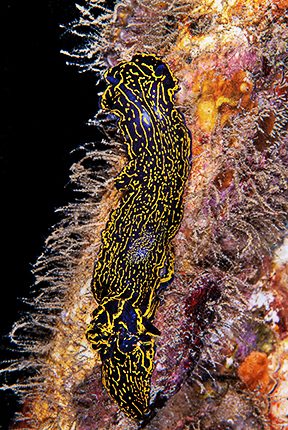“They’re on the sand! They’re on the sand!”
MY FELLOW DIVERS WERE ECSTATIC AFTER A TWILIGHT DIVE sur le Okinawa wreck near Pompano, Florida, in early June 2019. I was shooting wide angle and hadn’t paid much attention to small creatures during the dive, but they had found the holy grail for macro photographers: nudibranchs — in this case, regal sea goddesses (Felimare picta), which are giants among the sea slug species.
As time went on, we saw more and more goddesses on the Okinawa until it dawned on me that we had something unique here: a captive audience of sporadically seen nudibranchs. Florida’s artificial reef program had unwittingly provided a laboratory for studying these creatures and insights into questions such as how fast they grow, when they mate, and how long they live.
Nudibranchs are jewelry of the sea — beautiful creatures blessed with unimaginable colors and shapes. But as far back as 1975, as K.B. Clark, Ph.D., at the University of Connecticut Marine Research Laboratory lamented in Nudibranch Lifecycles in the Northeast Atlantic, “Relatively few studies have contained long-term observations of nudibranch populations.” Michael Middlebrooks, Ph.D., a sea slug specialist at the University of Tampa, opined, “I don’t know of any studies where individual sea slugs have been tracked in the wild.” But thanks to the artificial reef program, we checked that box.
Regal sea goddesses have navy blue bodies inscribed with yellow lines and often polka dots. They have two rhinophores in the front to detect scents and gills on their backs that look like royal crowns. Given my past employment as chief technology officer at the FBI, I wondered if those line patterns were unique, like fingerprints. After photographing 75 different sea goddesses from September 2020 through September 2021, there is little doubt that each one has a unique print.

We began tracking sea goddesses to determine how long they live, but once the database reached around 25 individuals, manually matching them was painstaking. My colleague, biology student Alex Strelkow, tried to match them using pattern-recognition software, but the goddesses caused us problems. They are rather fluffy, and usually we’d find them scrunched up eating or stretched out on the move. Their many possible shapes caused the software to struggle.
We continued by hand and separated the goddess patterns into different categories as we would do with fingerprints. There were four categories in all, depending on whether they had one, two, or three unbroken stripes on their backs or no stripes at all. Most of our goddesses had no stripes or at least one full stripe. The other two categories were much less common.
The sea goddesses blossomed in spring 2021 — it was not uncommon to find 15 on a single dive. The smallest we found was just under an inch long, excluding the foot (tail), because we often didn’t see it. They usually wrap the foot around their backs when they eat, so the sizes noted here are minus the foot unless otherwise specified.
They grow fast on a diet of blue ethereal sponge, gaining nearly half an inch or more every two weeks. Milky Way — yes, we named them — was a stunning sea goddess measuring more than 4 inches stretched out from its head to the end of its foot and was one of the longest we saw. It had an unexplainable puncture wound on its lower back, which healed within a few weeks, covered with a heavily dotted patch.
These nudibranchs grow fast because they live around eight months at most, but usually less than six. We derived this information by following the growth rate of our babies from the smallest (less than an inch) to adult size (2.5 inches on average) and how long we observed them on the ship as adults. Given an average growth rate of less than half an inch every two weeks, it takes them about two months to grow to average adult size.
We first saw Crooked Line, our longevity holder, as an adult on May 8 and again on Sept. 4. Given two months of growth from less than an inch, Crooked Line lived at least six months. How long did it take Crooked Line to grow from larval stage to about an inch? Here we can only speculate, but it is probably only a matter of months. We presume Crooked Line lived about eight months, while most others lived five or six months. They would simply disappear.
We frequently found the goddesses mating just about everywhere: outside the ship, inside the bunkrooms, and even over the head. Some nudibranchs display two connected tubes for sperm delivery during mating, but sea goddesses’ pudgy bodies afford them more modesty. Still, they are determined when mating, pushing against each other for about 10 to 15 minutes.
Mating also delivered my greatest shock — we saw a huge F. picta we named Doorman, nearly 4 inches stretched out, mating with what looked like a juvenile half its size. Apparently they reach sexual maturity much faster than we expected.
But with all this mating, one problem drove us crazy: We could never find their eggs. The ship is large enough that tiny creatures can slink into crevices where we cannot see them. A fair number of rocks dot the bottom surrounding the ship, but I’ve spent a lot of dive time scouring those rocks and coming away empty-handed.
Since that evening sea goddess encounter on the sand in June 2019, we have seen them crawling to and from the ship on the bottom. Perhaps they head out farther than the rock field to lay their eggs, or maybe they just need to get off the ship for a break. Only time will tell. But given the robustness of this population, we should be able to learn more about these loveable creatures and photograph them far into the future.